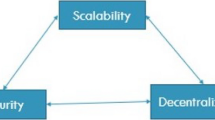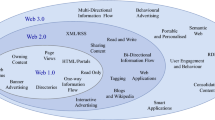Abstract
Blockchain technology has been increasingly integrated into various fields of economic and social development. However, scalability issues such as low broadcast efficiency, high communication overhead, and high redundant transmission rate have greatly limited the large-scale application of blockchain. This paper proposes a new scalability-enhanced Kademlia network protocol (SEKad), which optimizes blockchain network transmission in terms of both network topology and communication broadcast mechanism, provides a new approach to solving the scalability problem from the network layer. In SEKad protocol, firstly, SEKad employs a method that aligns the physical topology with the network topology for node clustering. This strategy groups neighboring nodes into clusters, streamlining network complexity and reducing network diameter. Secondly, SEKad presents a cluster-adaptable network topology based on Kademlia (Kad-CA). Kad-CA improves the rationality and efficiency of per-hop routing, optimizing the construction of K buckets and thus enhancing overall network efficiency. Finally, within the network transmission model, SEKad devise the smallest sub-tree broadcasting mechanism and the minimum redundant transmission mechanism for Kad-CA. These mechanisms work to reduce the redundant transmission rate, and enhance broadcasting efficiency. In order to evaluate the performance of SEKad, we built an experimental platform and conducted evaluations. The experimental results show that SEKad has better network scalability and stability, the network diameter size can be reduced by 27% and the redundant transmission rate can be reduced by 30%.















Similar content being viewed by others
Data availability
Available upon request.
References
Zarrin, J., Wen Phang, H., Babu Saheer, L., Zarrin, B.: Blockchain for decentralization of internet: prospects, trends, and challenges. Clust. Comput. 24(4), 2841–2866 (2021). https://doi.org/10.1007/s10586-021-03301-8
Dotan, M., Pignolet, Y.-A., Schmid, S., Tochner, S., Zohar, A.: Survey on blockchain networking: context, state-of-the-art, challenges. ACM Comput. Surv. (CSUR) 54(5), 1–34 (2021)
Makani, S., Pittala, R., Alsayed, E., Aloqaily, M., Jararweh, Y.: A survey of blockchain applications in sustainable and smart cities. Clust. Comput. 8, 1–22 (2022). https://doi.org/10.1007/s10586-022-03625-z
Zaghloul, E., Li, T., Mutka, M.W., Ren, J.: Bitcoin and blockchain: security and privacy. IEEE Internet Things J. 7(10), 10288–10313 (2020). https://doi.org/10.1109/JIOT.2020.3004273
Li, W., He, M.: Comparative analysis of bitcoin, ethereum, and libra. In: 2020 IEEE 11th International Conference on Software Engineering and Service Science (ICSESS), pp. 545–550 (2020). https://doi.org/10.1109/ICSESS49938.2020.9237710. IEEE
Sanka, A.I., Cheung, R.C.: A systematic review of blockchain scalability: issues, solutions, analysis and future research. J. Netw. Comput. Appl. 195, 103232 (2021). https://doi.org/10.1016/j.jnca.2021.103232
Antwi, R., Gadze, J.D., Tchao, E.T., Sikora, A., Nunoo-Mensah, H., Agbemenu, A.S., Obour Agyekum, K.O.B., Agyemang, J.O., Welte, D., Keelson, E.: A survey on network optimization techniques for blockchain systems. Algorithms 15(6), 193 (2022). https://doi.org/10.3390/a15060193
Zhang, L., Xu, H., Onireti, O., Imran, M.A., Cao, B.: How much communication resource is needed to run a wireless blockchain network? IEEE Netw. 36(1), 128–135 (2021). https://doi.org/10.1109/MNET.101.2100208
Xiao, Y., Zhang, N., Lou, W., Hou, Y.T.: A survey of distributed consensus protocols for blockchain networks. IEEE Commun. Surv. Tutor. 22(2), 1432–1465 (2020)
Kaur, G., Gandhi, C.: Scalability in blockchain: challenges and solutions. In: Handbook of Research on Blockchain Technology, pp. 373–406. Elsevier (2020)
Misic, J., Misic, V.B., Chang, X., Motlagh, S.G., Ali, M.Z.: Block delivery time in bitcoin distribution network. In: ICC 2019–2019 IEEE International Conference on Communications (ICC), pp. 1–7 (2019). https://doi.org/10.1109/ICC.2019.8761420. IEEE
Aoki, Y., Shudo, K.: Proximity neighbor selection in blockchain networks. In: 2019 IEEE International Conference on Blockchain (Blockchain), pp. 52–58 (2019). https://doi.org/10.1109/Blockchain.2019.00016. IEEE
Kiffer, L., Salman, A., Levin, D., Mislove, A., Nita-Rotaru, C.: Under the hood of the ethereum gossip protocol. In: International Conference on Financial Cryptography and Data Security, pp. 437–456 (2021). https://doi.org/10.1007/978-3-662-64331-0_23. Springer
Xu, X., Sun, G., Luo, L., Cao, H., Yu, H., Vasilakos, A.V.: Latency performance modeling and analysis for hyperledger fabric blockchain network. Inform. Process. Manag. 58(1), 102436 (2021). https://doi.org/10.1016/j.ipm.2020.102436
Neudecker, T., Hartenstein, H.: Network layer aspects of permissionless blockchains. IEEE Commun. Surv. Tutor. 21(1), 838–857 (2018)
Ripeanu, M., Foster, I., Iamnitchi, A.: Mapping the gnutella network: properties of large-scale peer-to-peer systems and implications for system design. arXiv preprint cs/0209028 (2002). https://doi.org/10.48550/arXiv.cs/0209028
Schollmeier, R.: A definition of peer-to-peer networking for the classification of peer-to-peer architectures and applications. In: Proceedings First International Conference on Peer-to-Peer Computing, pp. 101–102 (2001). https://doi.org/10.1109/P2P.2001.990434. IEEE
Maymounkov, P., Mazieres, D.: Kademlia: A peer-to-peer information system based on the xor metric. In: International Workshop on Peer-to-Peer Systems, pp. 53–65 (2002). https://doi.org/10.1007/3-540-45748-8_5. Springer
Czirkos, Z., Hosszú, G.: Enhancing the kademlia p2p network. Period. Polytech. Electr. Eng. (Archives) 54(3–4), 87–92 (2010). https://doi.org/10.3311/pp.ee.2010-3-4.01
Loizou, N., Richtárik, P.: Revisiting randomized gossip algorithms: general framework, convergence rates and novel block and accelerated protocols. IEEE Trans. Inform.Theory 67(12), 8300–8324 (2021). https://doi.org/10.1109/TIT.2021.3113285
Androulaki, E., Barger, A., Bortnikov, V., Cachin, C., Christidis, K., De Caro, A., Enyeart, D., Ferris, C., Laventman, G., Manevich, Y., et al.: Hyperledger fabric: a distributed operating system for permissioned blockchains. In: Proceedings of the Thirteenth EuroSys Conference, pp. 1–15 (2018). https://doi.org/10.1145/3190508.3190538
Boyd, S., Ghosh, A., Prabhakar, B., Shah, D.: Randomized gossip algorithms. IEEE Trans. Inform. Theory 52(6), 2508–2530 (2006). https://doi.org/10.1109/TIT.2006.874516
Jiang, S., Wu, J.: Taming propagation delay and fork rate in bitcoin mining network. In: 2021 IEEE International Conference on Blockchain (Blockchain), pp. 314–320 (2021). https://doi.org/10.1109/Blockchain53845.2021.00050. IEEE
Hao, W., Zeng, J., Dai, X., Xiao, J., Hua, Q.-S., Chen, H., Li, K.-C., Jin, H.: Towards a trust-enhanced blockchain p2p topology for enabling fast and reliable broadcast. IEEE Trans. Netwo. Serv. Manag. 17(2), 904–917 (2020). https://doi.org/10.1109/TNSM.2020.2980303
Yang, X., Shi, L.: Ari: a p2p optimization for blockchain systems. In: 2019 17th International Conference on Privacy, Security and Trust (PST), pp. 1–6 (2019). https://doi.org/10.1109/PST47121.2019.8949064. IEEE
Kaddoura, M., Bahr, N., Gambucci, E.: Sh-p2p: Self-healing peer-to-peer network with optimal multicast routing. In: 2022 IEEE International Conference on Electro Information Technology (eIT), pp. 027–031 (2022). https://doi.org/10.1109/eIT53891.2022.9813897. IEEE
Wang, H., Li, H., Wang, Z., Han, B., Zhang, M., Chong, P.H.J., Chu, X., Liu, Y., Liew, S.-Y., Wuttisittikulkij, L.: A p2p network topology for optimizing partition tolerance to reach the cap guarantee bound in consortium blockchains. arXiv preprint arXiv:2109.02907 (2021). https://doi.org/10.48550/arXiv.2109.02907
Kaneko, Y., Asaka, T.: Dht clustering for load balancing considering blockchain data size. In: 2018 Sixth International Symposium on Computing and Networking Workshops (CANDARW), pp. 71–74 (2018). https://doi.org/10.1109/CANDARW.2018.00022. IEEE
Huang, J., Tan, L., Mao, S., Yu, K.: Blockchain network propagation mechanism based on p4p architecture. Secur. Commun. Netw. 2021, 1–12 (2021)
Yu, B., Li, X., Zhao, H., Zhou, T.: A scalable blockchain network model with transmission paths and neighbor node subareas. Computing 104(10), 2253–2277 (2022). https://doi.org/10.1007/s00607-021-00913-1
Santiago, C., Lee, C.: Accelerating message propagation in blockchain networks. In: 2020 International Conference on Information and Communication Technology Convergence (ICTC), pp. 157–160 (2020). IEEE
Saldamli, G., Upadhyay, C., Jadhav, D., Shrishrimal, R., Patil, B., Tawalbeh, L.: Improved gossip protocol for blockchain applications. Clust. Comput. 25(3), 1915–1926 (2022). https://doi.org/10.1007/s10586-021-03504-z
Berendea, N., Mercier, H., Onica, E., Riviere, E.: Fair and efficient gossip in hyperledger fabric. In: 2020 IEEE 40th International Conference on Distributed Computing Systems (ICDCS), pp. 190–200 (2020). https://doi.org/10.1109/ICDCS47774.2020.00027. IEEE
Chen, J., Qin, Y.: Reducing block propagation delay in blockchain networks via guarantee verification. In: 2021 IEEE 29th International Conference on Network Protocols (ICNP), pp. 1–6 (2021). https://doi.org/10.1109/ICNP52444.2021.9651926. IEEE
Ayinala, K., Choi, B.-Y., Song, S.: Pichu: Accelerating block broadcasting in blockchain networks with pipelining and chunking. In: 2020 IEEE International Conference on Blockchain (Blockchain), pp. 221–228 (2020). https://doi.org/10.1109/Blockchain50366.2020.00035. IEEE
He, X., Cui, Y., Jiang, Y.: An improved gossip algorithm based on semi-distributed blockchain network. In: 2019 International Conference on Cyber-Enabled Distributed Computing and Knowledge Discovery (CyberC), pp. 24–27 (2019). https://doi.org/10.1109/CyberC.2019.00014. IEEE
Zhao, C., Wang, T., Zhang, S.: Lightblock: Reducing bandwidth required to synchronize blocks in ethereum network. In: 2021 International Conference on Communications, Information System and Computer Engineering (CISCE), pp. 868–874 (2021). https://doi.org/10.1109/CISCE52179.2021.9445911. IEEE
Wang, R., Njilla, L., Yu, S.: Ac: An ndn-based blockchain network with erasure coding. In: 2023 International Conference on Computing, Networking and Communications (ICNC), pp. 591–595 (2023). https://doi.org/10.1109/ICNC57223.2023.10074192. IEEE
Chen, P., Bai, F., Shen, T., Gong, B., Zhang, L., Huang, L., An, Z., Mir, T., Tu, S., Waqas, M.: Scca: a slicing-and coding-based consensus algorithm for optimizing storage in blockchain-based iot data sharing. Peer-to-Peer Netw. Appl. 15(4), 1964–1978 (2022)
Zhang, L., Wang, T., Liew, S.C.: Speeding up block propagation in bitcoin network: uncoded and coded designs. Comput. Netw. 206, 108791 (2022)
maxmind: GeoLite City Database. http://dev.maxmind.com/geoip/legacy/geolite/. Accessed 4 Oct, 2022
Montresor, A., Jelasity, M.: Peersim: A scalable p2p simulator. In: 2009 IEEE Ninth International Conference on Peer-to-Peer Computing, pp. 99–100 (2009). https://doi.org/10.1109/P2P.2009.5284506. IEEE
BitcoinNodes: Bitcoin network snapshot. https://bitnodes.io/nodes/. Accessed Otc 4, 2022
Funding
This work was supported in part by the Major Scientific and Technological Projects in Yunnan Province under Grant 202002AB080001-8; in part by the Yunnan Key Laboratory of Blockchain Application Technology under Grant 202105AG070005 and Project YNB202109 and YNB202115; in part by the National Natural Science Foundation of China under Grant 61971208; in part by the Yunnan Reserve Talents of Young and Middle-Aged Academic and Technical Leaders (Shen Tao) under Grant 2019HB005; in part by the Yunnan Young Top Talents of Ten thousand Plan (Shen Tao, Zhu Yan, Yunren Social Development) under Grant 2018 73; and in part by the Scientific Research Fund Project of Yunnan Provincial Department of Education under Grant 2022Y160.
Author information
Authors and Affiliations
Contributions
All authors contributed to the study conception and design. TS and QS did the ideal development and most of the implementation and evaluation. The first draft of the manuscript was written by QS. CZ contributed to the technical discussion as well as contributed to the manuscript writing and proofreading. As the corresponding author, FB supervised the entire process from idea development to implementation, experimentation and evaluation, and paper writing.
Corresponding author
Ethics declarations
Conflict of interest
The authors declare that they have no conflicts of interest.
Ethical approval
This material has not being published in whole or in part elsewhere.
Research invovling human and/or animal participants
This study does not involve human participants and/or animal research, which is used for non-life science journals.
Additional information
Publisher's Note
Springer Nature remains neutral with regard to jurisdictional claims in published maps and institutional affiliations.
Rights and permissions
Springer Nature or its licensor (e.g. a society or other partner) holds exclusive rights to this article under a publishing agreement with the author(s) or other rightsholder(s); author self-archiving of the accepted manuscript version of this article is solely governed by the terms of such publishing agreement and applicable law.
About this article
Cite this article
Shen, T., Sun, Q., Zhang, C. et al. SEKad: a scalable protocol for blockchain networks with enhanced broadcast efficiency. Cluster Comput (2023). https://doi.org/10.1007/s10586-023-04158-9
Received:
Revised:
Accepted:
Published:
DOI: https://doi.org/10.1007/s10586-023-04158-9




